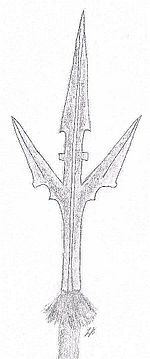Chauves Souris
| Chauves Souris | |
|---|---|

|
|
| Information | |
| Weapon type: | Korseke, polearm |
| Designations: | Chauves Souris |
| Use: | weapon |
| Working time: | around 15th century |
| Region of origin / author: |
France , knighthood |
| Distribution: | France |
| Overall length: | about 200 cm |
| Handle: | Wood |
| Lists on the subject | |
The Chauves Souris (French for bat ) is a polearm from France .
description
The Chauves Souris has three straight double-edged blades. After the spout, the blades branch out into a main blade and two side blades. The main blade is longer than the two side blades and usually has a central ridge. The side blades are pointed, on the outward facing side they are provided with arched indentations and points and usually also have a central ridge. A grommet is used to attach it to the shaft. The shaft is made of wood and at the transition from the shaft to the socket with a bush of wool fringes. The wool fringes serve to prevent the blood from getting onto the shaft when the weapon is used, as this can reduce the grip of the weapon. The side blades look like the wings of a bat , which is how the French name originated. The Chauves Souris is a version of the Korseke and was used around the 15th century .
Individual evidence
- ↑ George Cameron Stone: A Glossary of the Construction, Decoration and Use of Arms and Armor in all Countries and in all Times. Dover Publications, Mineola NY 1999, ISBN 0-486-40726-8 , pp. 176-177.
literature
- Bashford Dean: Handbook of Arms and Armor. European and Oriental. Including the William H. Riggs Collection. Metropolitan Museum of Art, New York NY 1915, p. 56 .
- Bashford Dean: Notes on arms and armor. Metropolitan Museum of Art, New York NY 1916, p. 140 .
- George A. Snook: The halberd and other European polearms, 1300-1650 (= Historical Arms Series. 38). Museum Restoration Service, Alexandria Bay NY 1998, ISBN 0-919316-38-7 , p. 15.